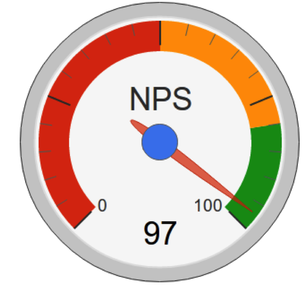
The Net Promoter Score is a key performance metric widely used by organizations across the world to measure the state of customer satisfaction with their products and services. It is based out of answers to a very short and simple survey asking customers if they’d be willing to recommend the company to a friend of a relative. The score is calculating by subtracting the percentage of detractors to the percentage of promoters.
History of the Net Promoter Score
Fred Reichheld is a business strategist who graduated from Harvard Business School in 1978 and has worked at Bain and Company, a strategy consulting firm, ever since. He is known for his published writings on customer loyalty and on what he calls “loyalty marketing.” He co-wrote “The Loyalty Effect: The Hidden Force behind Growth, Profits, and Lasting Value”, published in 2001, as well as “Loyalty Rules: How Today's Leaders Build Lasting Relationships” in 2003.
In studying customer satisfaction and customer experience topics, he became acutely aware of the limitations of traditional customer satisfaction surveys. These surveys are typically lengthy, (taking days or weeks to conduct and process), have low response rates, and have complex statistical algorithms built in that make it impossible for the common man to verify the soundness of the results. By the time these survey answers are processed and results come in, first, it is too late to win back unsatisfied customers, second, the results have so many shade of greys that they are difficult to act upon and don’t create accountability of the front line employees who have the power to impact the ultimate customer experience.
So he enrolled a small team of Bain Consultants on a research project. They set out to find the one survey question that would be a high predictor of future customer behaviors and ultimately company growth, and that could be collected and analyzed quickly. In December 2003 Fred Reichheld published an article in the Harvard Business Review (HBR) called the “The One Number You Need to Grow.” summarizing the findings of the research and where the Net Promoter Score metric and concept got introduced for the first time. He later (in 2006) published a book on the same topic titled “The Ultimate Question: Driving Good Profits and True Growth”. He expanded further on the subject, discerning more of the practical benefits of the metric, in a subsequent HBR article published in 2009 called “Closing the Customer Feedback Loop”. His research was revised and expanded into another book, co-authored with Rob Markey, a Bain partner colleague, that was published in 2011: “The Ultimate Question 2.0 (Revised and Expanded Edition): How Net Promoter Companies Thrive in a Customer-Driven World.”
Net Promoter Score Pros and Limitations
Net Promoter Score Pros
The brilliancy of the Net Promoter Score is in its simplicity, its high correlation with company growth rates in most industries, its simple and quick calculation (no obscure or complex algorithms), and its accessibility to front-line employees.
Net Promoter Score Limitations
The very high correlation of the Net Promoter Scores with growth rates can be observed in most industries. But, as Fred Reichheld observed in one of his research papers, this correlation becomes weaker when markets are, for example, dominated by monopolies (e.g. Cable) or highly regulated (e.g. utilities in a non-deregulated market). The correlation can also be distorted in industries with a high barrier to entry (i.e. very few competitors), a high switching cost wherein the customer is unhappy but stuck with the company’s product or service or with an addictive product such as cigarettes. Also, one could argue that a company could give away excellent products and services for free and therefore get a NPS score of 100, but that it would not lead to a sustainable and successful business, thereby invalidating the NPS. But that, of course, is a very unlikely scenario.
In conclusion, the Net Promoter Score is an important and significant predictor for the health and growth of a business but it is not the only one.
Other limitations cited are in the different interpretations that can be derived from a given score. For example, if the company has a zero Net Promoter Score , it could mean that all of their customers are passive or that 50% of their customers are promoters while 50% are detractors. But in both cases, the zero score still is a very good early warning sign that the company is not on a trajectory of growth and that something needs to be done.
Another observation is that only customers’ opinions are included in the calculation of a Net Promoter score. Imagining that a company could compute a NPS for each of its product lines and interrupt production of any one of them with an NPS of less than 80, one would still see the subsequent resulting NPS for the company at higher than 80.(However, that would not be synonymous with growth or a higher market share.)
Critics also point out that segmenting customers in only the three categories of promoters, passives and detractors is highly simplistic and may end up leaving precious information on the table.
Another criticism that often comes up is that non-responders are left out of the equation. Should they be counted as passives or detractors? Should they even be lumped in with responders at all? Nothing is ever perfect and, as a famous statistician once said, “All models are wrong, some are useful”.
Like every metric or model, the Net Promoter Score has its limitations, but understanding them helps in drawing the right insights from an NPS analysis. Advocates further point to the simplicity and practicality of the metric as outweighing any of its potential weaknesses.
Read NPS definition here

 RSS Feed
RSS Feed